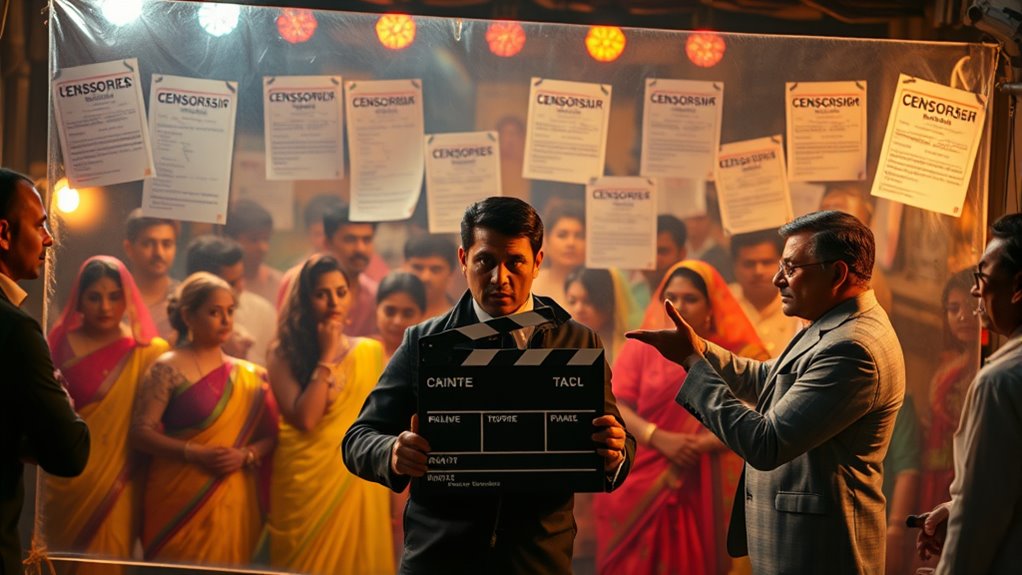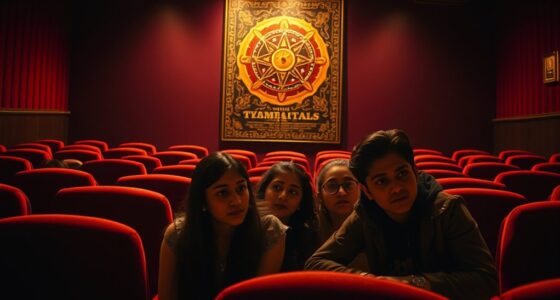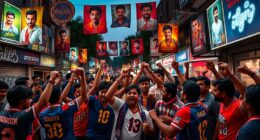Censorship in Bollywood has a long history of shaping films by balancing creative freedom with societal norms and sensitivities. The Central Board of Film Certification (CBFC) plays a key role, often editing or banning content that challenges traditional values, religion, or addresses sexuality. Controversies, like those around “Padmaavat” or “Lipstick Under My Burkha,” highlight ongoing tensions between artistic expression and cultural controls. If you keep exploring, you’ll uncover more about how censorship continues to influence Bollywood’s evolving landscape.
Key Takeaways
- The CBFC primarily enforces content guidelines balancing creative freedom with cultural sensitivities in Bollywood.
- Films like “Padmaavat” and “Lipstick Under My Burkha” faced bans or heavy censorship, sparking controversy.
- Deep-rooted social norms influence censorship decisions, especially regarding sexuality, religion, and caste portrayals.
- Censorship often leads to edits, bans, or disclaimers, reflecting societal tensions between artistic expression and cultural values.
- Ongoing debates question whether censorship hinders progress or preserves societal norms in Bollywood cinema.

Have you ever wondered how censorship shapes Bollywood movies? It’s a complex dance between filmmakers’ desire for creative freedom and the authorities’ efforts to uphold cultural sensitivities. Censorship in Bollywood has long been a contentious issue because it directly impacts the freedom of expression. While filmmakers aim to tell compelling stories, they often find themselves steering through a maze of restrictions designed to protect societal values. This balancing act can sometimes stifle artistic expression, leading to debates over what should be allowed on screen and what should be kept behind closed doors. The government’s censorship board, historically known as the Central Board of Film Certification (CBFC), plays a pivotal role in determining what content is suitable for public viewing. Its guidelines are rooted in preserving cultural sensitivities, which often means censoring scenes that could be perceived as controversial or offensive to certain social or religious groups.
Cultural sensitivities are deeply ingrained in India’s social fabric, and they influence censorship decisions more than anything else. Films that challenge traditional norms, portray sexuality, or depict religious or caste identities in a controversial light often face cuts or bans. For instance, movies that push boundaries with provocative language or scenes may be edited heavily or released with disclaimers. Sometimes, filmmakers choose to self-censor to avoid conflicts or delays, fearing backlash or legal trouble. But this creates a tension—should filmmakers prioritize creative expression or adhere to societal expectations? The answer isn’t always clear, and it has led to numerous controversies over the years. Films like “Padmaavat” and “Lipstick Under My Burkha” faced bans or heavy censorship due to their content clashing with conservative values, sparking heated debates about artistic liberty versus cultural respect.
Nevertheless, censorship isn’t solely about suppression; it’s also about steering through the delicate landscape of cultural sensitivities. It’s a way for authorities to prevent content they believe could incite unrest or offend community sentiments. Yet, it raises questions about whether such restrictions hinder societal progress or merely protect outdated norms. Filmmakers, actors, and audiences alike have voiced their concerns, arguing that excessive censorship hampers creativity and the honest portrayal of society’s realities. Striking the right balance remains a challenge—how to respect cultural sensitivities without stifling freedom of expression. The ongoing debate continues to shape Bollywood’s film industry, illustrating the constant push and pull between artistic freedom and societal values.
In addition, the influence of dog breeds and their representation in media has often reflected societal norms and cultural perceptions, which can be subtly linked to the broader themes of censorship and societal control.
Frequently Asked Questions
How Has Censorship Impacted Bollywood’s Creative Freedom Historically?
You see, censorship has often limited your artistic expression in Bollywood, imposing creative restrictions that shape how stories are told. It forces filmmakers to modify scenes, dialogues, or themes, sometimes diluting their original vision. This pressure can stifle innovation and prevent honest storytelling. As a result, your ability to explore sensitive issues freely gets compromised, impacting the overall richness and diversity of Bollywood’s cinematic landscape.
What Are the Key Government Bodies Responsible for Film Censorship?
You should know that government agencies like the Central Board of Film Certification (CBFC) are responsible for enforcing censorship policies in India. They review films before release, ensuring they comply with standards and guidelines. The CBFC, along with regional boards and the Ministry of Information and Broadcasting, oversee censorship policies, often deciding what content is acceptable. These bodies markedly influence Bollywood’s creative freedom by approving or restricting certain scenes and themes.
How Do Filmmakers Typically Respond to Censorship Demands?
Like a river resisting a dam, you often push back against censorship demands, refusing to let restrictions dam your creative flow. Filmmakers typically respond with resistance, challenging edits, or negotiating to keep their vision intact. Sometimes, they modify scenes or dialogue to satisfy censors, but they also stand firm in censorship negotiations, endeavoring to balance artistic expression with compliance. Your goal is to preserve authenticity without losing your message.
Are There Notable Cases of Banned Bollywood Films?
You’ll find notable controversies where Bollywood films faced historical bans due to sensitive content. For example, “Padmaavat” faced protests and bans over its portrayal of historical figures, while “Kama Sutra: A Tale of Love” was banned for explicit scenes. These bans often spark debates about artistic freedom versus cultural sensitivities, highlighting how censorship continues to influence Indian cinema’s boundaries and provoke public discussion.
What Role Does Public Opinion Play in Censorship Decisions?
Public opinion acts like a compass guiding censorship decisions, shaping what gets approved or banned. You influence this process through your feedback, protests, and support or opposition to films. Audience sentiment holds significant weight, often swaying authorities to modify or restrict content. When the public’s voice is loud and clear, censorship boards tend to align their choices with what viewers find acceptable, ensuring films reflect societal values or avoid controversy.
Conclusion
As you explore Bollywood’s history of censorship, it’s clear that many believe it’s driven by political motives rather than moral concerns. This theory suggests that censorship isn’t just about protecting societal values but also about controlling narratives and silencing dissent. Feel the frustration? It’s a reminder that artistic freedom often battles powerful forces. Staying aware of these struggles helps you see films in a new light, appreciating the fight for true expression behind every scene.









